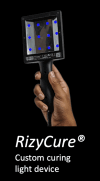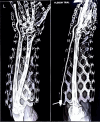Evolution in Casting Techniques: A Narrative Review of Casting Methods, Techniques, and Innovation
- PMID: 38435235
- PMCID: PMC10908428
- DOI: 10.7759/cureus.53454
Evolution in Casting Techniques: A Narrative Review of Casting Methods, Techniques, and Innovation
Abstract
Orthopedic casting has seen a remarkable evolution from ancient practices to cutting-edge innovations. Beginning with ancient Egyptian methods employing bark, linen, and bandages, casting techniques have progressed through historical milestones, including the adoption of plaster of Paris in the 19th century and the introduction of synthetic materials like fiberglass and thermoplastics in the 20th century. Historical progressions transitioned from primitive materials to more sophisticated techniques, such as resin-soaked bandages and starch-based casts. While thermoplastics showcased benefits like adjustability and comfort, widespread adoption faced hurdles due to cost and water resistance limitations. The emergence of 3D printing introduced patient-specific casts with improved ventilation but faced challenges in accessibility, cost, and immediate immobilization. FlexiOH presents as a groundbreaking foam cast by Orthoheal, offering customizable fit, lightweight design, improved ventilation, and moisture resistance. Its potential to reduce ER visits, enhance patient comfort, and streamline application procedures positions it as a promising technology for the future. This paper discusses each casting generation's advantages and drawbacks, highlighting the potential of innovative technologies like FlexiOH to revolutionize orthopedic casting practices, promising improved outcomes, reduced costs, and enhanced efficiency.
Keywords: casting advancements; casting innovation; casting methods; casting techniques; casting technology; flexioh; narrative review; orthopedic casting.
Copyright © 2024, Scheinberg et al.
Conflict of interest statement
The authors have declared that no competing interests exist.
Figures






Similar articles
-
Plaster: our orthopaedic heritage: AAOS exhibit selection.J Bone Joint Surg Am. 2012 Oct 17;94(20):e152. doi: 10.2106/JBJS.L.00183. J Bone Joint Surg Am. 2012. PMID: 23079886 Review.
-
Revolution in orthopedic immobilization materials: A comprehensive review.Heliyon. 2023 Feb 16;9(3):e13640. doi: 10.1016/j.heliyon.2023.e13640. eCollection 2023 Mar. Heliyon. 2023. PMID: 36915506 Free PMC article. Review.
-
Cast changes: synthetic versus plaster.Pediatr Nurs. 1997 Jul-Aug;23(4):422, 425-7. Pediatr Nurs. 1997. PMID: 9282058 Review.
-
Safety and Efficacy of Casting during COVID-19 Pandemic: A Comparison of the Mechanical Properties of Polymers Used for 3D Printing to Conventional Materials Used for the Generation of Orthopaedic Orthoses.Arch Bone Jt Surg. 2020 Apr;8(Suppl 1):281-285. doi: 10.22038/abjs.2020.44038.2204. Arch Bone Jt Surg. 2020. PMID: 32733983 Free PMC article.
-
Effect of pressure applied during casting on temperatures beneath casts.J Pediatr Orthop. 2011 Oct-Nov;31(7):791-7. doi: 10.1097/BPO.0b013e31822d3897. J Pediatr Orthop. 2011. PMID: 21926879
Cited by
-
Knowledge-Based Expert System for Orthopedic Injury Management With Integrated Transcutaneous Electrical Nerve Simulation Therapy.Int J Telemed Appl. 2025 Jun 23;2025:5878245. doi: 10.1155/ijta/5878245. eCollection 2025. Int J Telemed Appl. 2025. PMID: 40589776 Free PMC article.
-
Hip Spica Cast Application.J Pediatr Soc North Am. 2025 Jul 3;12:100242. doi: 10.1016/j.jposna.2025.100242. eCollection 2025 Aug. J Pediatr Soc North Am. 2025. PMID: 40791970 Free PMC article. Review.
References
-
- Evaluation of fiberglass versus plaster of Paris for immobilization of fractures of the arm and leg. Kowalski KL, Pitcher JD Jr, Bickley B. https://pubmed.ncbi.nlm.nih.gov/12188237/ Mil Med. 2002;167:657–661. - PubMed
Publication types
LinkOut - more resources
Full Text Sources
Miscellaneous
